University Business Finance: Investment Valuation Techniques Report
VerifiedAdded on 2022/11/14
|12
|2429
|66
Report
AI Summary
This report provides a detailed analysis of investment valuation techniques in business finance, focusing on tools like Net Present Value (NPV), Internal Rate of Return (IRR), Accounting Rate of Return (ARR), and Payback Period. It illustrates these techniques with a case study involving Auditzz Electronics, calculating cash flows, and performing sensitivity analyses to assess the impact of changing prices and demand. The report examines the feasibility of an investment, comparing IRR and NPV against required rates of return, and discusses the relationship between positive NPV and the efficient market hypothesis. It concludes with recommendations for organizations to make informed investment decisions by carefully evaluating profitability and feasibility using both discounted and non-discounted methods. The report emphasizes the importance of these techniques in making conscious investment decisions.

Running head: BUSINESS FINANCE
Business Finance
Name of the Student:
Name of the University:
Author’s Note:
Business Finance
Name of the Student:
Name of the University:
Author’s Note:
Paraphrase This Document
Need a fresh take? Get an instant paraphrase of this document with our AI Paraphraser
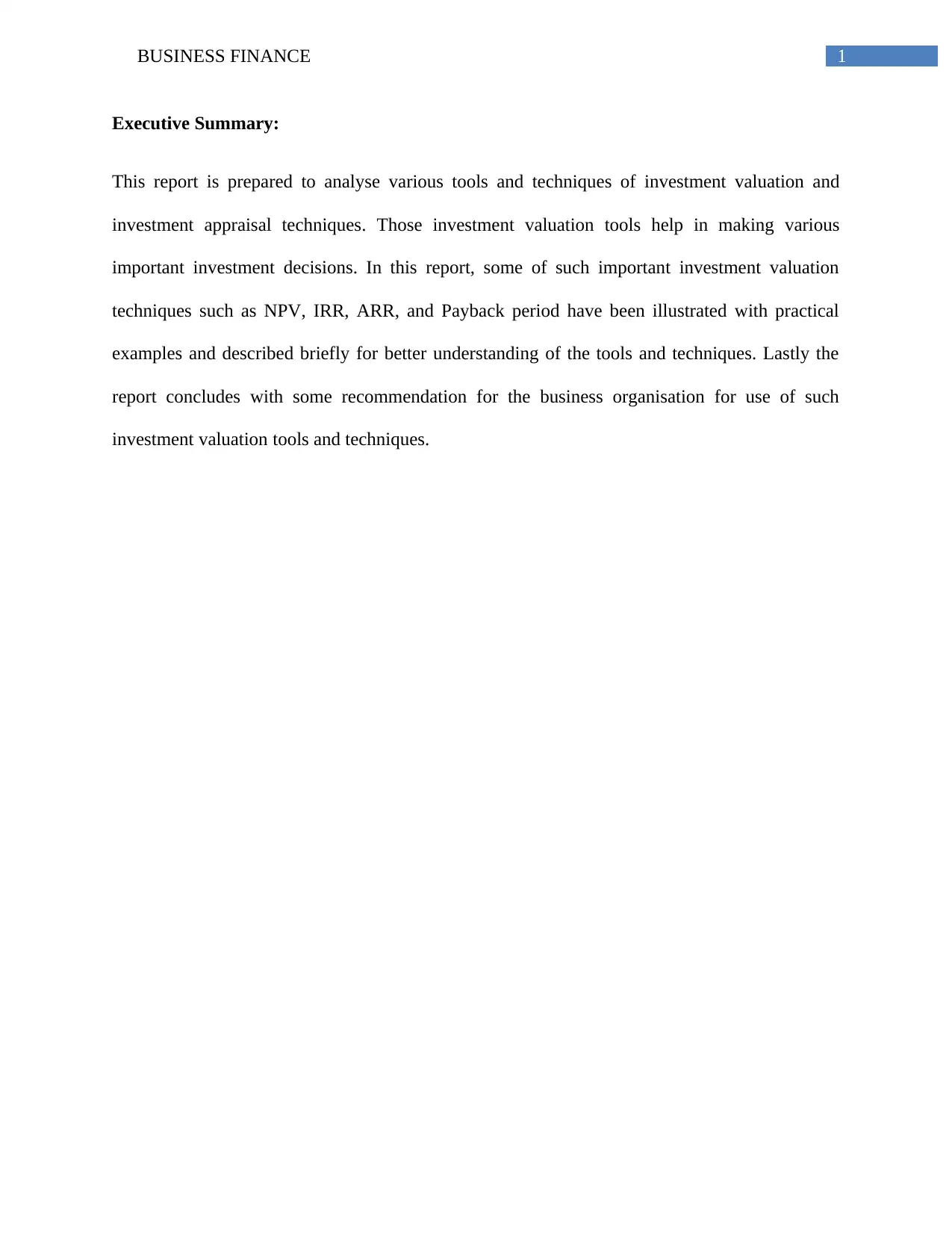
1BUSINESS FINANCE
Executive Summary:
This report is prepared to analyse various tools and techniques of investment valuation and
investment appraisal techniques. Those investment valuation tools help in making various
important investment decisions. In this report, some of such important investment valuation
techniques such as NPV, IRR, ARR, and Payback period have been illustrated with practical
examples and described briefly for better understanding of the tools and techniques. Lastly the
report concludes with some recommendation for the business organisation for use of such
investment valuation tools and techniques.
Executive Summary:
This report is prepared to analyse various tools and techniques of investment valuation and
investment appraisal techniques. Those investment valuation tools help in making various
important investment decisions. In this report, some of such important investment valuation
techniques such as NPV, IRR, ARR, and Payback period have been illustrated with practical
examples and described briefly for better understanding of the tools and techniques. Lastly the
report concludes with some recommendation for the business organisation for use of such
investment valuation tools and techniques.
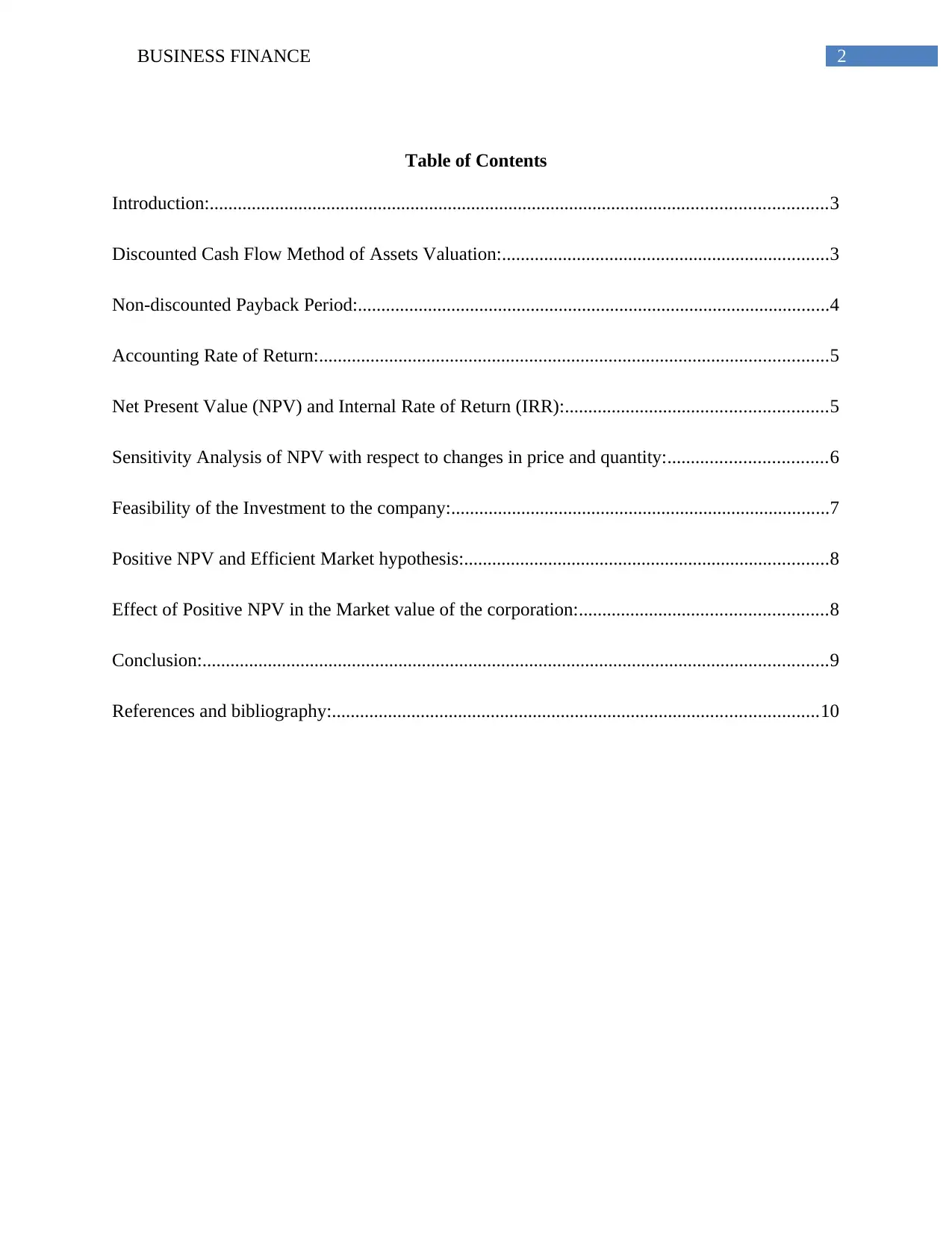
2BUSINESS FINANCE
Table of Contents
Introduction:....................................................................................................................................3
Discounted Cash Flow Method of Assets Valuation:......................................................................3
Non-discounted Payback Period:.....................................................................................................4
Accounting Rate of Return:.............................................................................................................5
Net Present Value (NPV) and Internal Rate of Return (IRR):........................................................5
Sensitivity Analysis of NPV with respect to changes in price and quantity:..................................6
Feasibility of the Investment to the company:.................................................................................7
Positive NPV and Efficient Market hypothesis:..............................................................................8
Effect of Positive NPV in the Market value of the corporation:.....................................................8
Conclusion:......................................................................................................................................9
References and bibliography:........................................................................................................10
Table of Contents
Introduction:....................................................................................................................................3
Discounted Cash Flow Method of Assets Valuation:......................................................................3
Non-discounted Payback Period:.....................................................................................................4
Accounting Rate of Return:.............................................................................................................5
Net Present Value (NPV) and Internal Rate of Return (IRR):........................................................5
Sensitivity Analysis of NPV with respect to changes in price and quantity:..................................6
Feasibility of the Investment to the company:.................................................................................7
Positive NPV and Efficient Market hypothesis:..............................................................................8
Effect of Positive NPV in the Market value of the corporation:.....................................................8
Conclusion:......................................................................................................................................9
References and bibliography:........................................................................................................10
⊘ This is a preview!⊘
Do you want full access?
Subscribe today to unlock all pages.

Trusted by 1+ million students worldwide
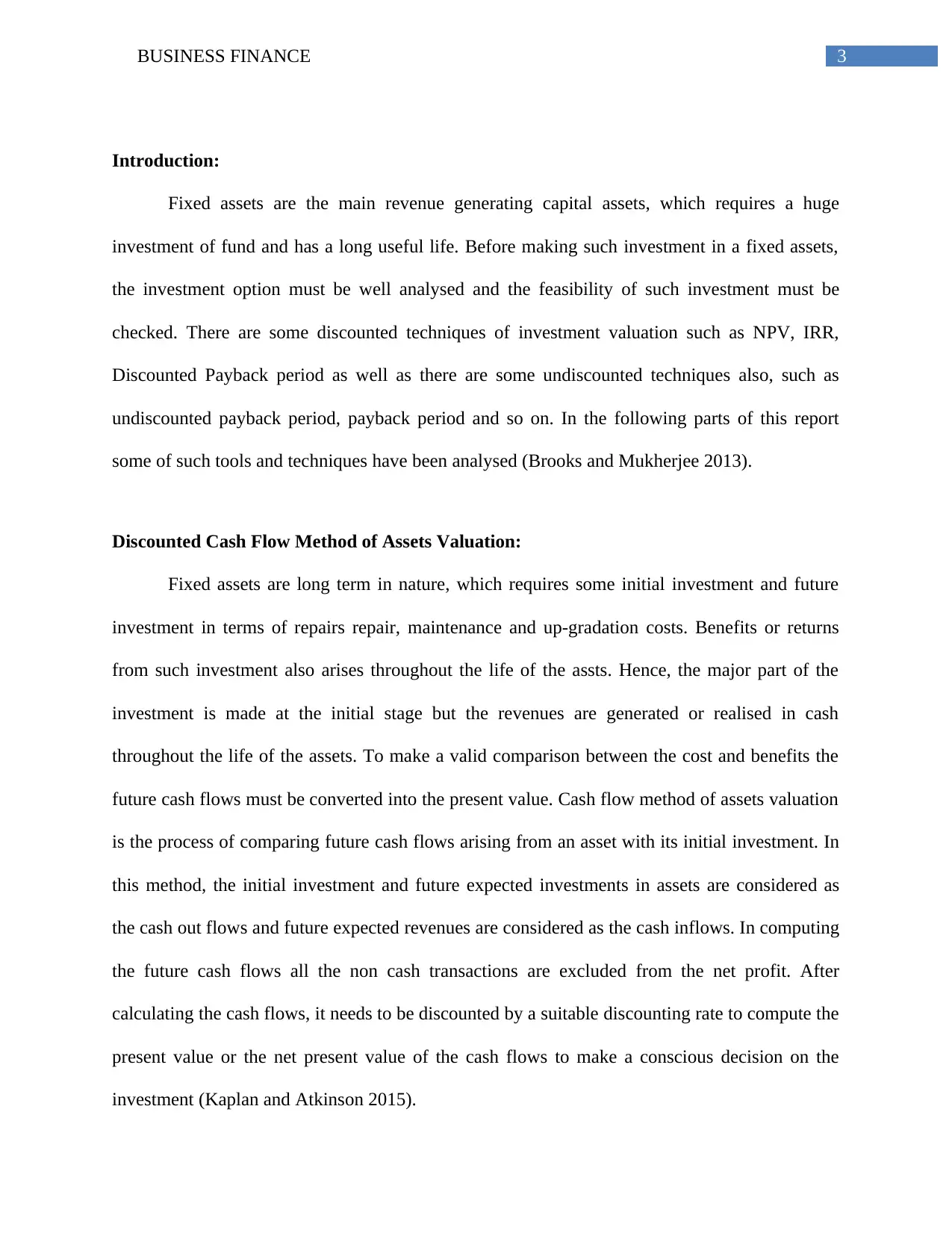
3BUSINESS FINANCE
Introduction:
Fixed assets are the main revenue generating capital assets, which requires a huge
investment of fund and has a long useful life. Before making such investment in a fixed assets,
the investment option must be well analysed and the feasibility of such investment must be
checked. There are some discounted techniques of investment valuation such as NPV, IRR,
Discounted Payback period as well as there are some undiscounted techniques also, such as
undiscounted payback period, payback period and so on. In the following parts of this report
some of such tools and techniques have been analysed (Brooks and Mukherjee 2013).
Discounted Cash Flow Method of Assets Valuation:
Fixed assets are long term in nature, which requires some initial investment and future
investment in terms of repairs repair, maintenance and up-gradation costs. Benefits or returns
from such investment also arises throughout the life of the assts. Hence, the major part of the
investment is made at the initial stage but the revenues are generated or realised in cash
throughout the life of the assets. To make a valid comparison between the cost and benefits the
future cash flows must be converted into the present value. Cash flow method of assets valuation
is the process of comparing future cash flows arising from an asset with its initial investment. In
this method, the initial investment and future expected investments in assets are considered as
the cash out flows and future expected revenues are considered as the cash inflows. In computing
the future cash flows all the non cash transactions are excluded from the net profit. After
calculating the cash flows, it needs to be discounted by a suitable discounting rate to compute the
present value or the net present value of the cash flows to make a conscious decision on the
investment (Kaplan and Atkinson 2015).
Introduction:
Fixed assets are the main revenue generating capital assets, which requires a huge
investment of fund and has a long useful life. Before making such investment in a fixed assets,
the investment option must be well analysed and the feasibility of such investment must be
checked. There are some discounted techniques of investment valuation such as NPV, IRR,
Discounted Payback period as well as there are some undiscounted techniques also, such as
undiscounted payback period, payback period and so on. In the following parts of this report
some of such tools and techniques have been analysed (Brooks and Mukherjee 2013).
Discounted Cash Flow Method of Assets Valuation:
Fixed assets are long term in nature, which requires some initial investment and future
investment in terms of repairs repair, maintenance and up-gradation costs. Benefits or returns
from such investment also arises throughout the life of the assts. Hence, the major part of the
investment is made at the initial stage but the revenues are generated or realised in cash
throughout the life of the assets. To make a valid comparison between the cost and benefits the
future cash flows must be converted into the present value. Cash flow method of assets valuation
is the process of comparing future cash flows arising from an asset with its initial investment. In
this method, the initial investment and future expected investments in assets are considered as
the cash out flows and future expected revenues are considered as the cash inflows. In computing
the future cash flows all the non cash transactions are excluded from the net profit. After
calculating the cash flows, it needs to be discounted by a suitable discounting rate to compute the
present value or the net present value of the cash flows to make a conscious decision on the
investment (Kaplan and Atkinson 2015).
Paraphrase This Document
Need a fresh take? Get an instant paraphrase of this document with our AI Paraphraser
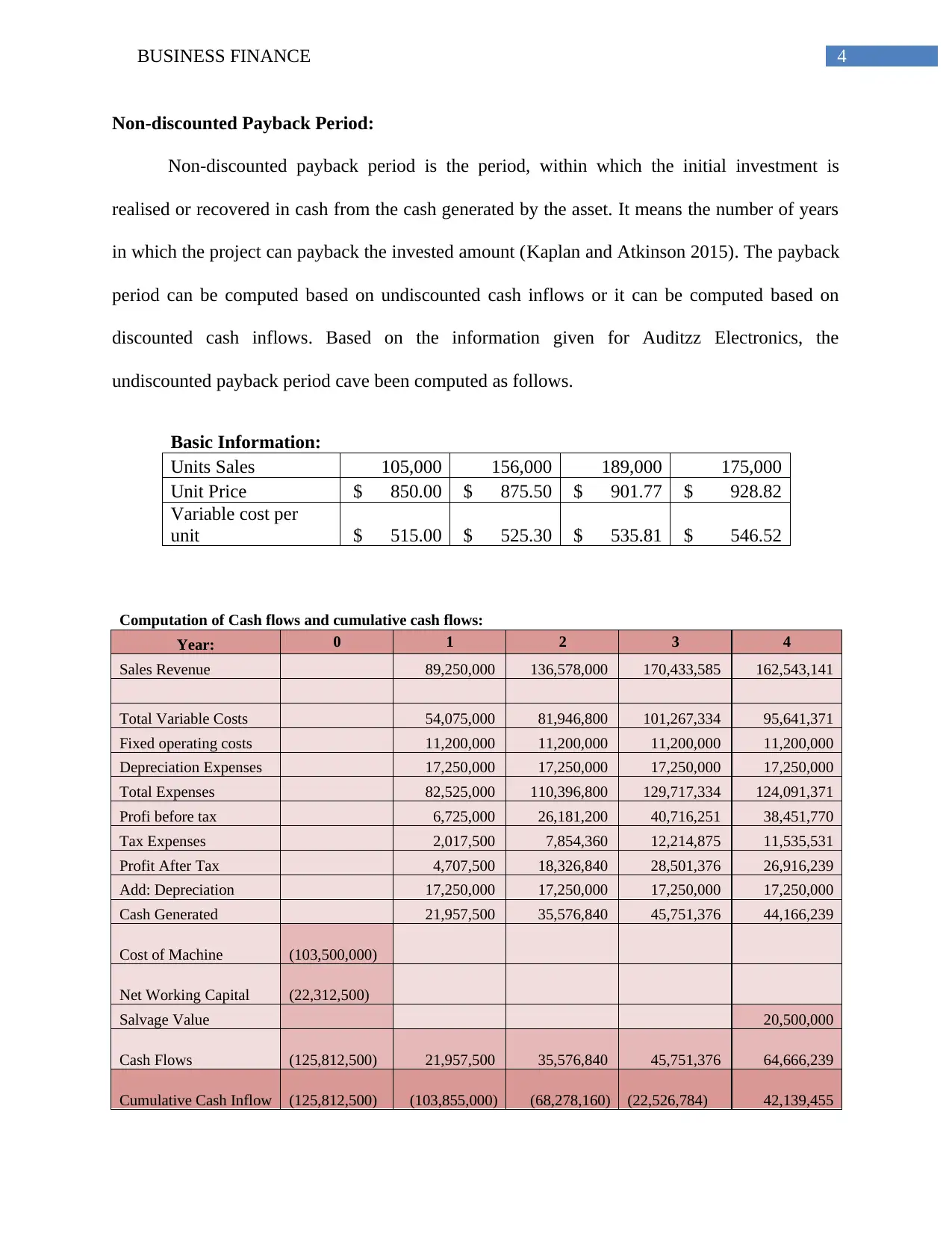
4BUSINESS FINANCE
Non-discounted Payback Period:
Non-discounted payback period is the period, within which the initial investment is
realised or recovered in cash from the cash generated by the asset. It means the number of years
in which the project can payback the invested amount (Kaplan and Atkinson 2015). The payback
period can be computed based on undiscounted cash inflows or it can be computed based on
discounted cash inflows. Based on the information given for Auditzz Electronics, the
undiscounted payback period cave been computed as follows.
Basic Information:
Units Sales 105,000 156,000 189,000 175,000
Unit Price $ 850.00 $ 875.50 $ 901.77 $ 928.82
Variable cost per
unit $ 515.00 $ 525.30 $ 535.81 $ 546.52
Computation of Cash flows and cumulative cash flows:
Year: 0 1 2 3 4
Sales Revenue 89,250,000 136,578,000 170,433,585 162,543,141
Total Variable Costs 54,075,000 81,946,800 101,267,334 95,641,371
Fixed operating costs 11,200,000 11,200,000 11,200,000 11,200,000
Depreciation Expenses 17,250,000 17,250,000 17,250,000 17,250,000
Total Expenses 82,525,000 110,396,800 129,717,334 124,091,371
Profi before tax 6,725,000 26,181,200 40,716,251 38,451,770
Tax Expenses 2,017,500 7,854,360 12,214,875 11,535,531
Profit After Tax 4,707,500 18,326,840 28,501,376 26,916,239
Add: Depreciation 17,250,000 17,250,000 17,250,000 17,250,000
Cash Generated 21,957,500 35,576,840 45,751,376 44,166,239
Cost of Machine (103,500,000)
Net Working Capital (22,312,500)
Salvage Value 20,500,000
Cash Flows (125,812,500) 21,957,500 35,576,840 45,751,376 64,666,239
Cumulative Cash Inflow (125,812,500) (103,855,000) (68,278,160) (22,526,784) 42,139,455
Non-discounted Payback Period:
Non-discounted payback period is the period, within which the initial investment is
realised or recovered in cash from the cash generated by the asset. It means the number of years
in which the project can payback the invested amount (Kaplan and Atkinson 2015). The payback
period can be computed based on undiscounted cash inflows or it can be computed based on
discounted cash inflows. Based on the information given for Auditzz Electronics, the
undiscounted payback period cave been computed as follows.
Basic Information:
Units Sales 105,000 156,000 189,000 175,000
Unit Price $ 850.00 $ 875.50 $ 901.77 $ 928.82
Variable cost per
unit $ 515.00 $ 525.30 $ 535.81 $ 546.52
Computation of Cash flows and cumulative cash flows:
Year: 0 1 2 3 4
Sales Revenue 89,250,000 136,578,000 170,433,585 162,543,141
Total Variable Costs 54,075,000 81,946,800 101,267,334 95,641,371
Fixed operating costs 11,200,000 11,200,000 11,200,000 11,200,000
Depreciation Expenses 17,250,000 17,250,000 17,250,000 17,250,000
Total Expenses 82,525,000 110,396,800 129,717,334 124,091,371
Profi before tax 6,725,000 26,181,200 40,716,251 38,451,770
Tax Expenses 2,017,500 7,854,360 12,214,875 11,535,531
Profit After Tax 4,707,500 18,326,840 28,501,376 26,916,239
Add: Depreciation 17,250,000 17,250,000 17,250,000 17,250,000
Cash Generated 21,957,500 35,576,840 45,751,376 44,166,239
Cost of Machine (103,500,000)
Net Working Capital (22,312,500)
Salvage Value 20,500,000
Cash Flows (125,812,500) 21,957,500 35,576,840 45,751,376 64,666,239
Cumulative Cash Inflow (125,812,500) (103,855,000) (68,278,160) (22,526,784) 42,139,455
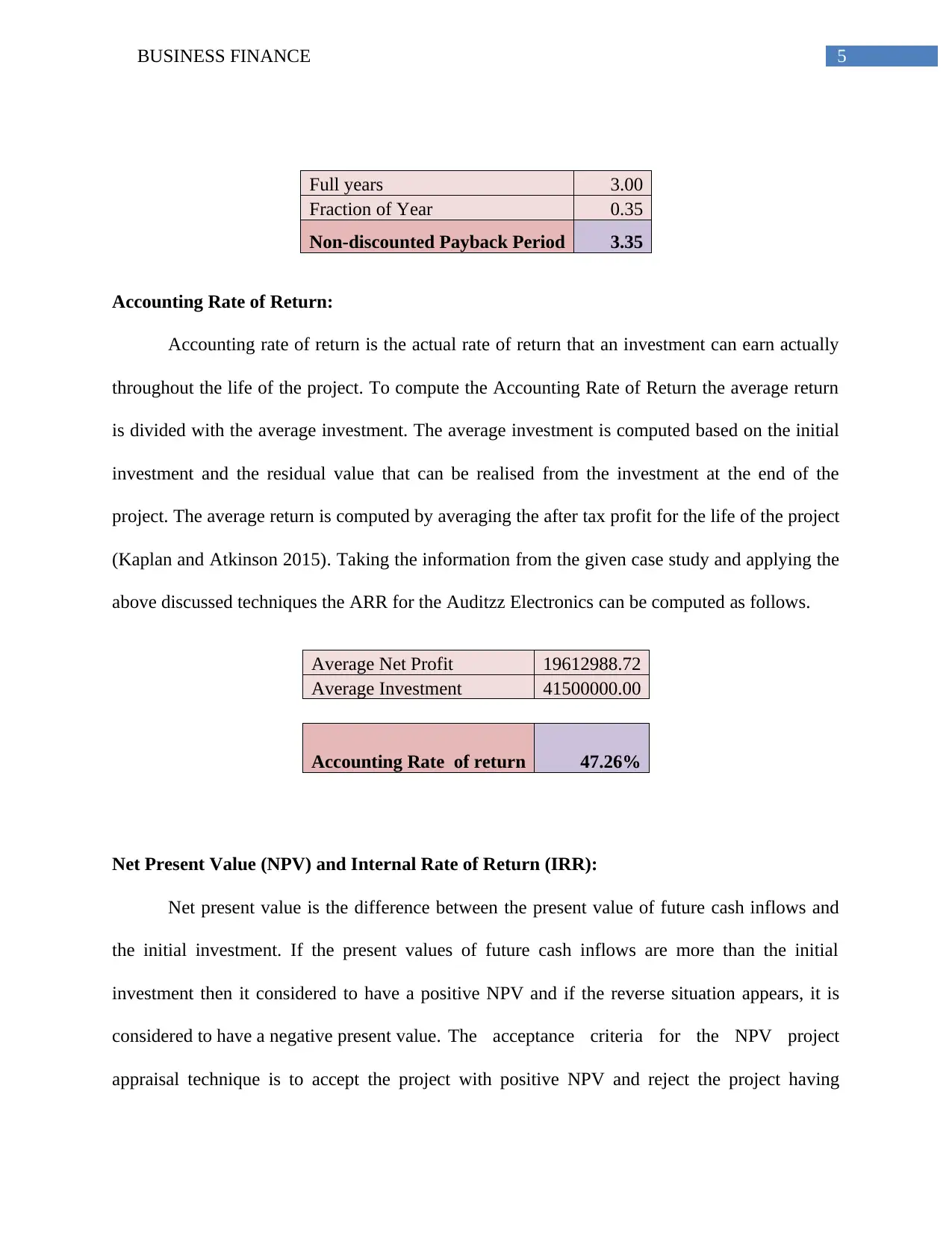
5BUSINESS FINANCE
Full years 3.00
Fraction of Year 0.35
Non-discounted Payback Period 3.35
Accounting Rate of Return:
Accounting rate of return is the actual rate of return that an investment can earn actually
throughout the life of the project. To compute the Accounting Rate of Return the average return
is divided with the average investment. The average investment is computed based on the initial
investment and the residual value that can be realised from the investment at the end of the
project. The average return is computed by averaging the after tax profit for the life of the project
(Kaplan and Atkinson 2015). Taking the information from the given case study and applying the
above discussed techniques the ARR for the Auditzz Electronics can be computed as follows.
Average Net Profit 19612988.72
Average Investment 41500000.00
Accounting Rate of return 47.26%
Net Present Value (NPV) and Internal Rate of Return (IRR):
Net present value is the difference between the present value of future cash inflows and
the initial investment. If the present values of future cash inflows are more than the initial
investment then it considered to have a positive NPV and if the reverse situation appears, it is
considered to have a negative present value. The acceptance criteria for the NPV project
appraisal technique is to accept the project with positive NPV and reject the project having
Full years 3.00
Fraction of Year 0.35
Non-discounted Payback Period 3.35
Accounting Rate of Return:
Accounting rate of return is the actual rate of return that an investment can earn actually
throughout the life of the project. To compute the Accounting Rate of Return the average return
is divided with the average investment. The average investment is computed based on the initial
investment and the residual value that can be realised from the investment at the end of the
project. The average return is computed by averaging the after tax profit for the life of the project
(Kaplan and Atkinson 2015). Taking the information from the given case study and applying the
above discussed techniques the ARR for the Auditzz Electronics can be computed as follows.
Average Net Profit 19612988.72
Average Investment 41500000.00
Accounting Rate of return 47.26%
Net Present Value (NPV) and Internal Rate of Return (IRR):
Net present value is the difference between the present value of future cash inflows and
the initial investment. If the present values of future cash inflows are more than the initial
investment then it considered to have a positive NPV and if the reverse situation appears, it is
considered to have a negative present value. The acceptance criteria for the NPV project
appraisal technique is to accept the project with positive NPV and reject the project having
⊘ This is a preview!⊘
Do you want full access?
Subscribe today to unlock all pages.

Trusted by 1+ million students worldwide
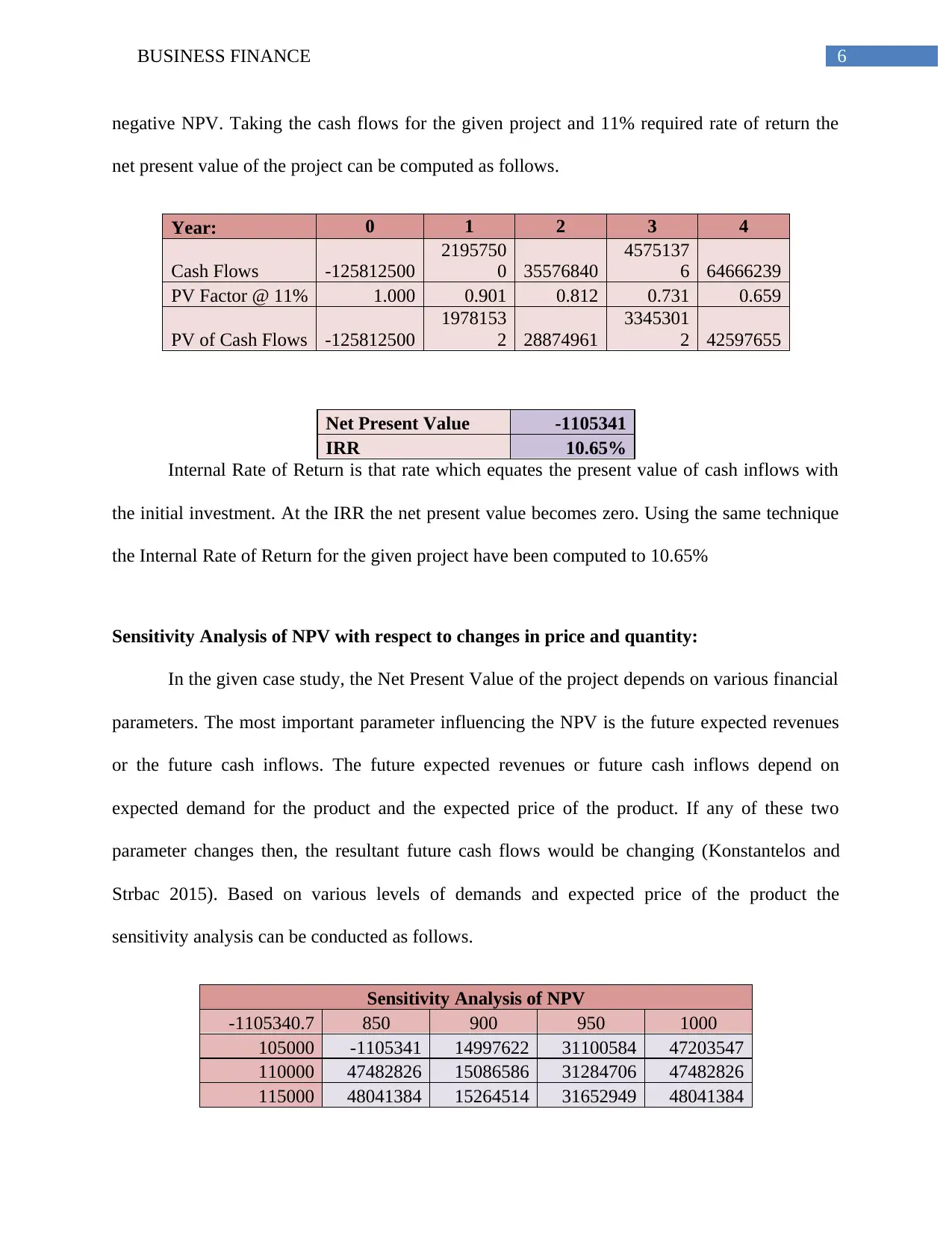
6BUSINESS FINANCE
negative NPV. Taking the cash flows for the given project and 11% required rate of return the
net present value of the project can be computed as follows.
Year: 0 1 2 3 4
Cash Flows -125812500
2195750
0 35576840
4575137
6 64666239
PV Factor @ 11% 1.000 0.901 0.812 0.731 0.659
PV of Cash Flows -125812500
1978153
2 28874961
3345301
2 42597655
Net Present Value -1105341
IRR 10.65%
Internal Rate of Return is that rate which equates the present value of cash inflows with
the initial investment. At the IRR the net present value becomes zero. Using the same technique
the Internal Rate of Return for the given project have been computed to 10.65%
Sensitivity Analysis of NPV with respect to changes in price and quantity:
In the given case study, the Net Present Value of the project depends on various financial
parameters. The most important parameter influencing the NPV is the future expected revenues
or the future cash inflows. The future expected revenues or future cash inflows depend on
expected demand for the product and the expected price of the product. If any of these two
parameter changes then, the resultant future cash flows would be changing (Konstantelos and
Strbac 2015). Based on various levels of demands and expected price of the product the
sensitivity analysis can be conducted as follows.
Sensitivity Analysis of NPV
-1105340.7 850 900 950 1000
105000 -1105341 14997622 31100584 47203547
110000 47482826 15086586 31284706 47482826
115000 48041384 15264514 31652949 48041384
negative NPV. Taking the cash flows for the given project and 11% required rate of return the
net present value of the project can be computed as follows.
Year: 0 1 2 3 4
Cash Flows -125812500
2195750
0 35576840
4575137
6 64666239
PV Factor @ 11% 1.000 0.901 0.812 0.731 0.659
PV of Cash Flows -125812500
1978153
2 28874961
3345301
2 42597655
Net Present Value -1105341
IRR 10.65%
Internal Rate of Return is that rate which equates the present value of cash inflows with
the initial investment. At the IRR the net present value becomes zero. Using the same technique
the Internal Rate of Return for the given project have been computed to 10.65%
Sensitivity Analysis of NPV with respect to changes in price and quantity:
In the given case study, the Net Present Value of the project depends on various financial
parameters. The most important parameter influencing the NPV is the future expected revenues
or the future cash inflows. The future expected revenues or future cash inflows depend on
expected demand for the product and the expected price of the product. If any of these two
parameter changes then, the resultant future cash flows would be changing (Konstantelos and
Strbac 2015). Based on various levels of demands and expected price of the product the
sensitivity analysis can be conducted as follows.
Sensitivity Analysis of NPV
-1105340.7 850 900 950 1000
105000 -1105341 14997622 31100584 47203547
110000 47482826 15086586 31284706 47482826
115000 48041384 15264514 31652949 48041384
Paraphrase This Document
Need a fresh take? Get an instant paraphrase of this document with our AI Paraphraser
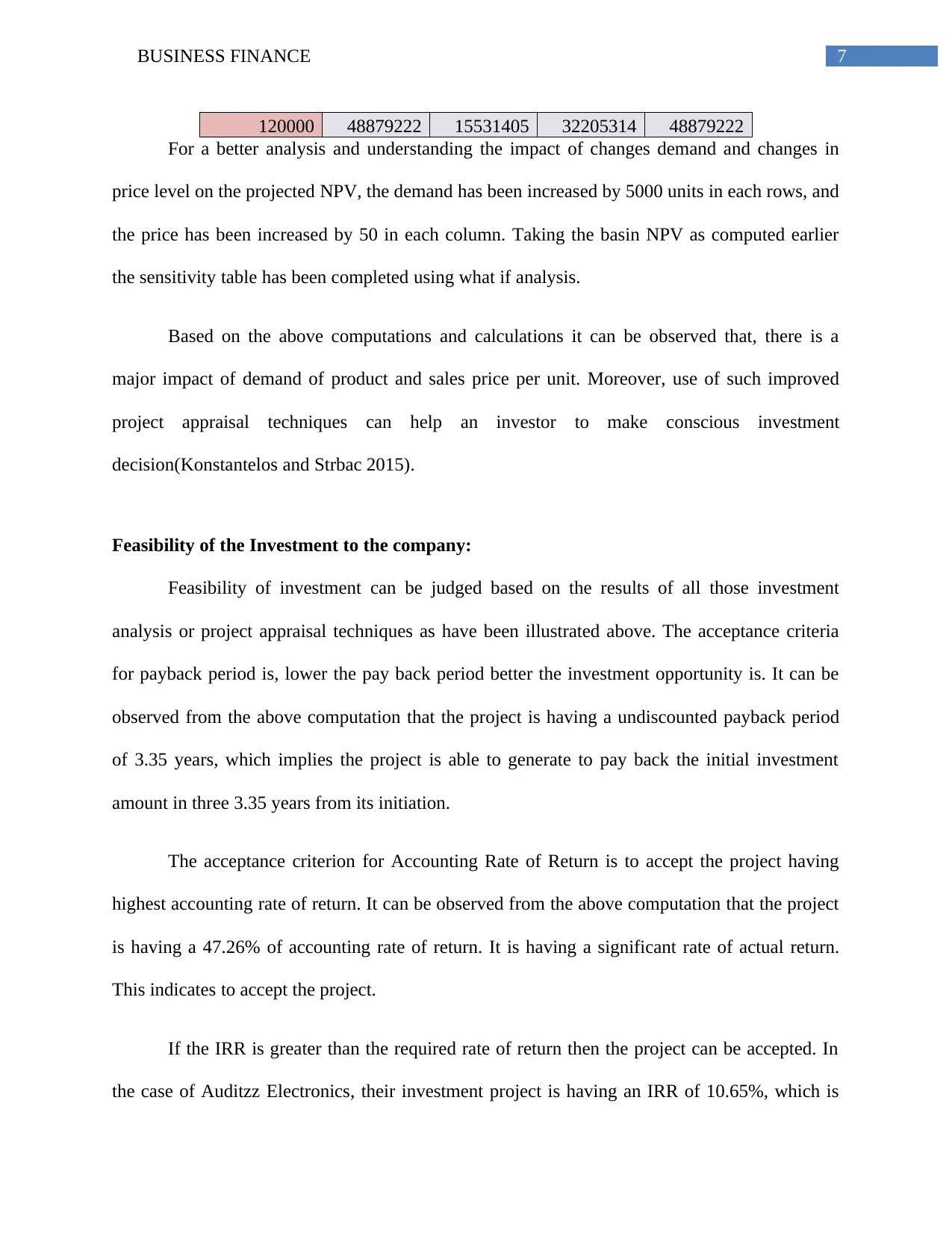
7BUSINESS FINANCE
120000 48879222 15531405 32205314 48879222
For a better analysis and understanding the impact of changes demand and changes in
price level on the projected NPV, the demand has been increased by 5000 units in each rows, and
the price has been increased by 50 in each column. Taking the basin NPV as computed earlier
the sensitivity table has been completed using what if analysis.
Based on the above computations and calculations it can be observed that, there is a
major impact of demand of product and sales price per unit. Moreover, use of such improved
project appraisal techniques can help an investor to make conscious investment
decision(Konstantelos and Strbac 2015).
Feasibility of the Investment to the company:
Feasibility of investment can be judged based on the results of all those investment
analysis or project appraisal techniques as have been illustrated above. The acceptance criteria
for payback period is, lower the pay back period better the investment opportunity is. It can be
observed from the above computation that the project is having a undiscounted payback period
of 3.35 years, which implies the project is able to generate to pay back the initial investment
amount in three 3.35 years from its initiation.
The acceptance criterion for Accounting Rate of Return is to accept the project having
highest accounting rate of return. It can be observed from the above computation that the project
is having a 47.26% of accounting rate of return. It is having a significant rate of actual return.
This indicates to accept the project.
If the IRR is greater than the required rate of return then the project can be accepted. In
the case of Auditzz Electronics, their investment project is having an IRR of 10.65%, which is
120000 48879222 15531405 32205314 48879222
For a better analysis and understanding the impact of changes demand and changes in
price level on the projected NPV, the demand has been increased by 5000 units in each rows, and
the price has been increased by 50 in each column. Taking the basin NPV as computed earlier
the sensitivity table has been completed using what if analysis.
Based on the above computations and calculations it can be observed that, there is a
major impact of demand of product and sales price per unit. Moreover, use of such improved
project appraisal techniques can help an investor to make conscious investment
decision(Konstantelos and Strbac 2015).
Feasibility of the Investment to the company:
Feasibility of investment can be judged based on the results of all those investment
analysis or project appraisal techniques as have been illustrated above. The acceptance criteria
for payback period is, lower the pay back period better the investment opportunity is. It can be
observed from the above computation that the project is having a undiscounted payback period
of 3.35 years, which implies the project is able to generate to pay back the initial investment
amount in three 3.35 years from its initiation.
The acceptance criterion for Accounting Rate of Return is to accept the project having
highest accounting rate of return. It can be observed from the above computation that the project
is having a 47.26% of accounting rate of return. It is having a significant rate of actual return.
This indicates to accept the project.
If the IRR is greater than the required rate of return then the project can be accepted. In
the case of Auditzz Electronics, their investment project is having an IRR of 10.65%, which is
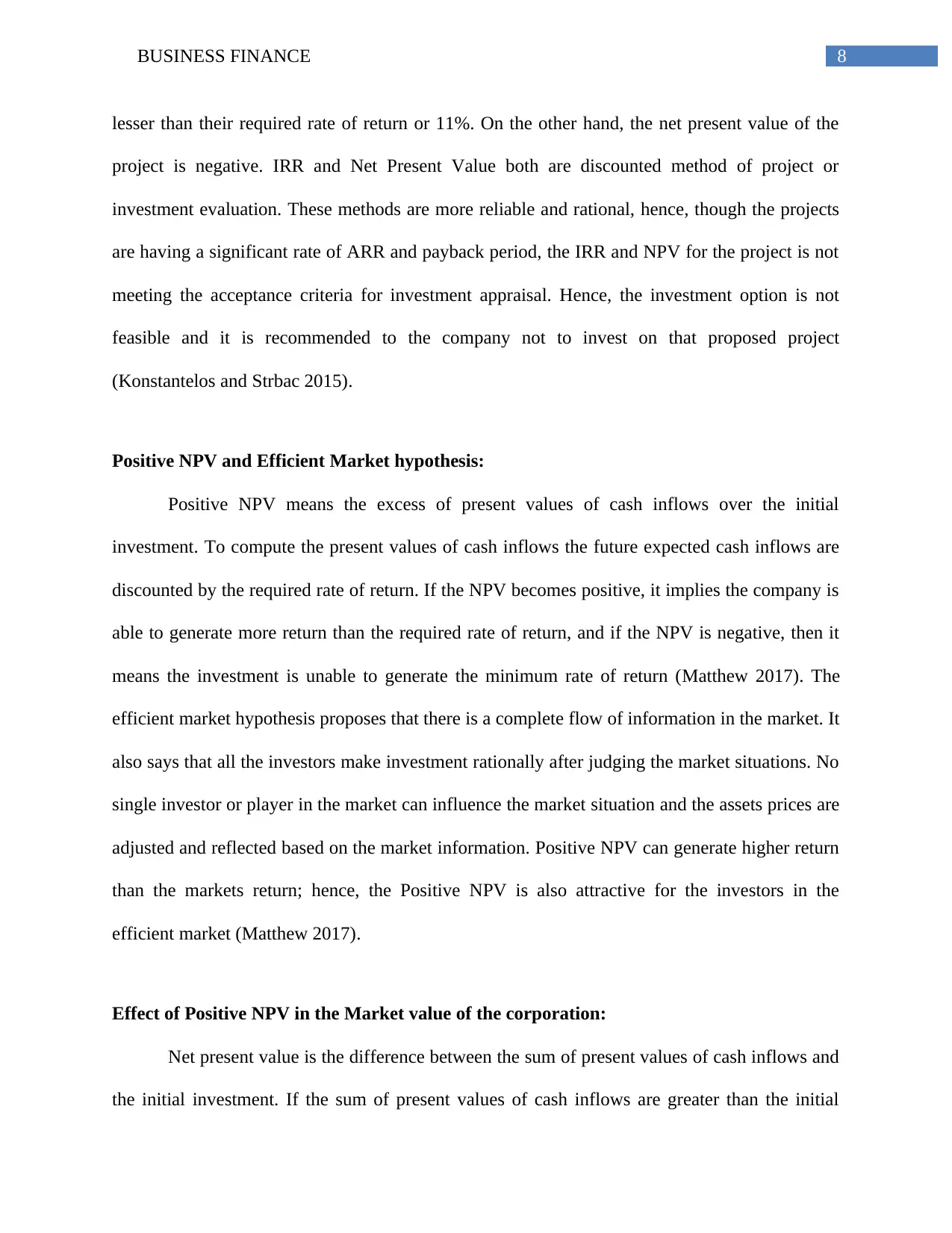
8BUSINESS FINANCE
lesser than their required rate of return or 11%. On the other hand, the net present value of the
project is negative. IRR and Net Present Value both are discounted method of project or
investment evaluation. These methods are more reliable and rational, hence, though the projects
are having a significant rate of ARR and payback period, the IRR and NPV for the project is not
meeting the acceptance criteria for investment appraisal. Hence, the investment option is not
feasible and it is recommended to the company not to invest on that proposed project
(Konstantelos and Strbac 2015).
Positive NPV and Efficient Market hypothesis:
Positive NPV means the excess of present values of cash inflows over the initial
investment. To compute the present values of cash inflows the future expected cash inflows are
discounted by the required rate of return. If the NPV becomes positive, it implies the company is
able to generate more return than the required rate of return, and if the NPV is negative, then it
means the investment is unable to generate the minimum rate of return (Matthew 2017). The
efficient market hypothesis proposes that there is a complete flow of information in the market. It
also says that all the investors make investment rationally after judging the market situations. No
single investor or player in the market can influence the market situation and the assets prices are
adjusted and reflected based on the market information. Positive NPV can generate higher return
than the markets return; hence, the Positive NPV is also attractive for the investors in the
efficient market (Matthew 2017).
Effect of Positive NPV in the Market value of the corporation:
Net present value is the difference between the sum of present values of cash inflows and
the initial investment. If the sum of present values of cash inflows are greater than the initial
lesser than their required rate of return or 11%. On the other hand, the net present value of the
project is negative. IRR and Net Present Value both are discounted method of project or
investment evaluation. These methods are more reliable and rational, hence, though the projects
are having a significant rate of ARR and payback period, the IRR and NPV for the project is not
meeting the acceptance criteria for investment appraisal. Hence, the investment option is not
feasible and it is recommended to the company not to invest on that proposed project
(Konstantelos and Strbac 2015).
Positive NPV and Efficient Market hypothesis:
Positive NPV means the excess of present values of cash inflows over the initial
investment. To compute the present values of cash inflows the future expected cash inflows are
discounted by the required rate of return. If the NPV becomes positive, it implies the company is
able to generate more return than the required rate of return, and if the NPV is negative, then it
means the investment is unable to generate the minimum rate of return (Matthew 2017). The
efficient market hypothesis proposes that there is a complete flow of information in the market. It
also says that all the investors make investment rationally after judging the market situations. No
single investor or player in the market can influence the market situation and the assets prices are
adjusted and reflected based on the market information. Positive NPV can generate higher return
than the markets return; hence, the Positive NPV is also attractive for the investors in the
efficient market (Matthew 2017).
Effect of Positive NPV in the Market value of the corporation:
Net present value is the difference between the sum of present values of cash inflows and
the initial investment. If the sum of present values of cash inflows are greater than the initial
⊘ This is a preview!⊘
Do you want full access?
Subscribe today to unlock all pages.

Trusted by 1+ million students worldwide
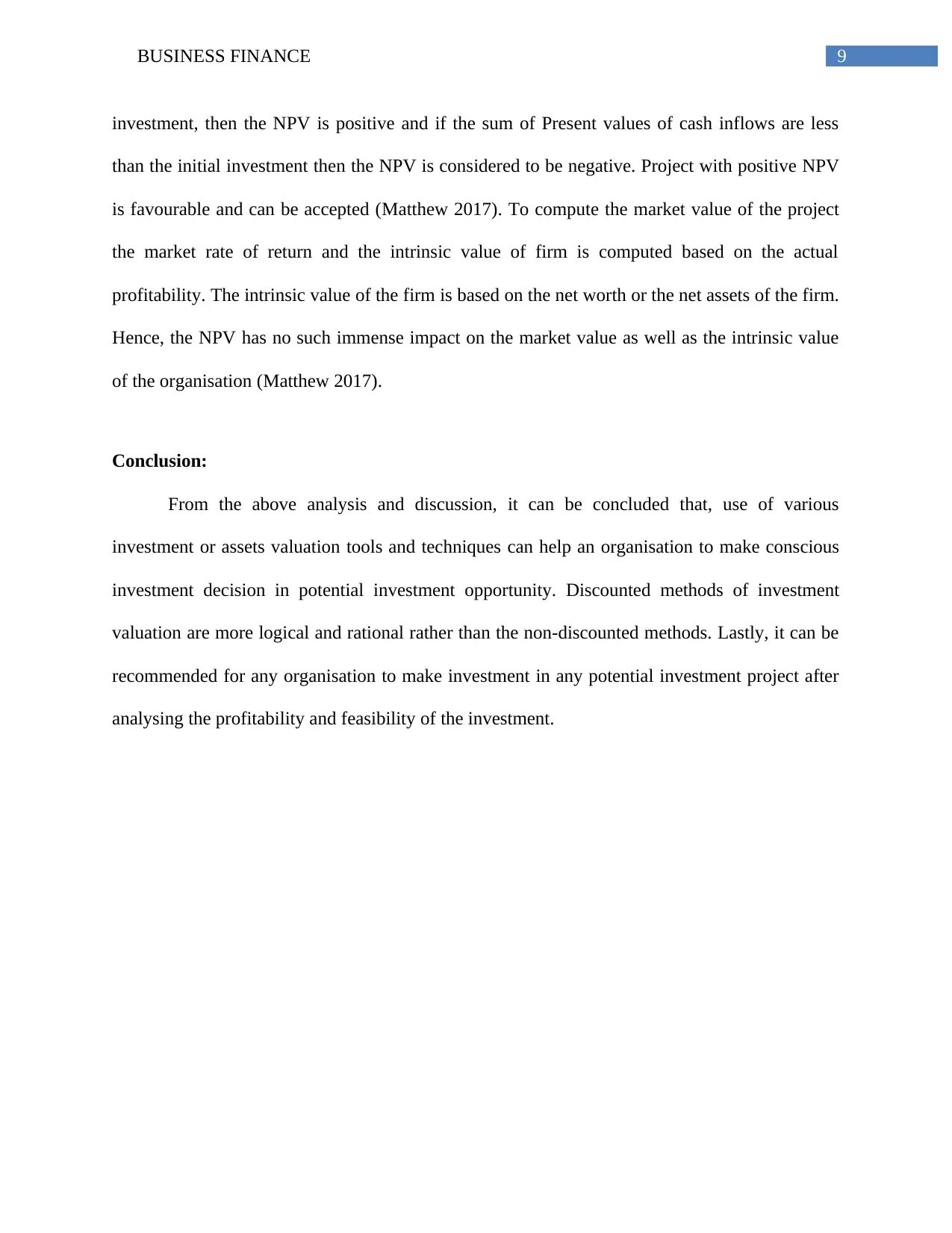
9BUSINESS FINANCE
investment, then the NPV is positive and if the sum of Present values of cash inflows are less
than the initial investment then the NPV is considered to be negative. Project with positive NPV
is favourable and can be accepted (Matthew 2017). To compute the market value of the project
the market rate of return and the intrinsic value of firm is computed based on the actual
profitability. The intrinsic value of the firm is based on the net worth or the net assets of the firm.
Hence, the NPV has no such immense impact on the market value as well as the intrinsic value
of the organisation (Matthew 2017).
Conclusion:
From the above analysis and discussion, it can be concluded that, use of various
investment or assets valuation tools and techniques can help an organisation to make conscious
investment decision in potential investment opportunity. Discounted methods of investment
valuation are more logical and rational rather than the non-discounted methods. Lastly, it can be
recommended for any organisation to make investment in any potential investment project after
analysing the profitability and feasibility of the investment.
investment, then the NPV is positive and if the sum of Present values of cash inflows are less
than the initial investment then the NPV is considered to be negative. Project with positive NPV
is favourable and can be accepted (Matthew 2017). To compute the market value of the project
the market rate of return and the intrinsic value of firm is computed based on the actual
profitability. The intrinsic value of the firm is based on the net worth or the net assets of the firm.
Hence, the NPV has no such immense impact on the market value as well as the intrinsic value
of the organisation (Matthew 2017).
Conclusion:
From the above analysis and discussion, it can be concluded that, use of various
investment or assets valuation tools and techniques can help an organisation to make conscious
investment decision in potential investment opportunity. Discounted methods of investment
valuation are more logical and rational rather than the non-discounted methods. Lastly, it can be
recommended for any organisation to make investment in any potential investment project after
analysing the profitability and feasibility of the investment.
Paraphrase This Document
Need a fresh take? Get an instant paraphrase of this document with our AI Paraphraser
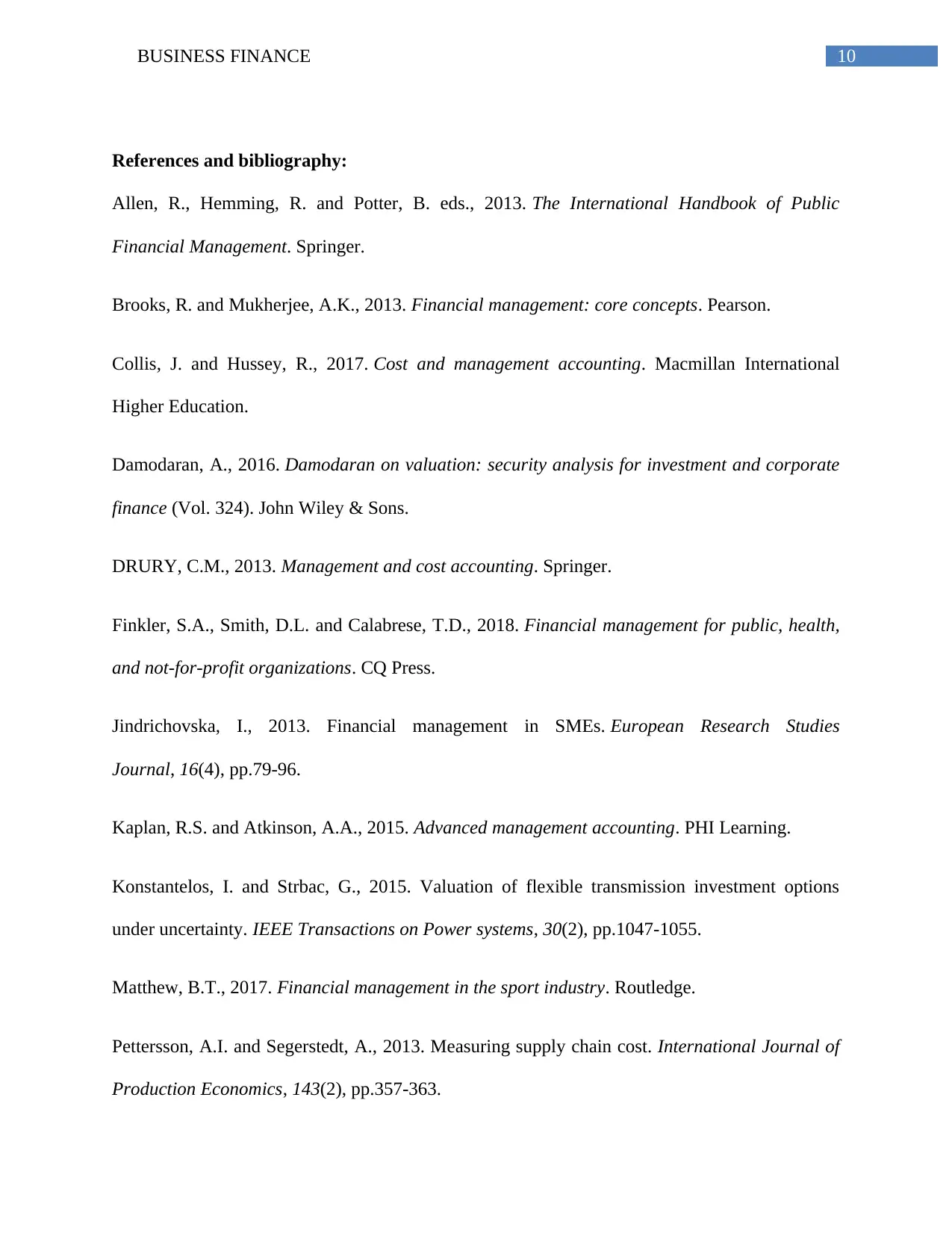
10BUSINESS FINANCE
References and bibliography:
Allen, R., Hemming, R. and Potter, B. eds., 2013. The International Handbook of Public
Financial Management. Springer.
Brooks, R. and Mukherjee, A.K., 2013. Financial management: core concepts. Pearson.
Collis, J. and Hussey, R., 2017. Cost and management accounting. Macmillan International
Higher Education.
Damodaran, A., 2016. Damodaran on valuation: security analysis for investment and corporate
finance (Vol. 324). John Wiley & Sons.
DRURY, C.M., 2013. Management and cost accounting. Springer.
Finkler, S.A., Smith, D.L. and Calabrese, T.D., 2018. Financial management for public, health,
and not-for-profit organizations. CQ Press.
Jindrichovska, I., 2013. Financial management in SMEs. European Research Studies
Journal, 16(4), pp.79-96.
Kaplan, R.S. and Atkinson, A.A., 2015. Advanced management accounting. PHI Learning.
Konstantelos, I. and Strbac, G., 2015. Valuation of flexible transmission investment options
under uncertainty. IEEE Transactions on Power systems, 30(2), pp.1047-1055.
Matthew, B.T., 2017. Financial management in the sport industry. Routledge.
Pettersson, A.I. and Segerstedt, A., 2013. Measuring supply chain cost. International Journal of
Production Economics, 143(2), pp.357-363.
References and bibliography:
Allen, R., Hemming, R. and Potter, B. eds., 2013. The International Handbook of Public
Financial Management. Springer.
Brooks, R. and Mukherjee, A.K., 2013. Financial management: core concepts. Pearson.
Collis, J. and Hussey, R., 2017. Cost and management accounting. Macmillan International
Higher Education.
Damodaran, A., 2016. Damodaran on valuation: security analysis for investment and corporate
finance (Vol. 324). John Wiley & Sons.
DRURY, C.M., 2013. Management and cost accounting. Springer.
Finkler, S.A., Smith, D.L. and Calabrese, T.D., 2018. Financial management for public, health,
and not-for-profit organizations. CQ Press.
Jindrichovska, I., 2013. Financial management in SMEs. European Research Studies
Journal, 16(4), pp.79-96.
Kaplan, R.S. and Atkinson, A.A., 2015. Advanced management accounting. PHI Learning.
Konstantelos, I. and Strbac, G., 2015. Valuation of flexible transmission investment options
under uncertainty. IEEE Transactions on Power systems, 30(2), pp.1047-1055.
Matthew, B.T., 2017. Financial management in the sport industry. Routledge.
Pettersson, A.I. and Segerstedt, A., 2013. Measuring supply chain cost. International Journal of
Production Economics, 143(2), pp.357-363.

11BUSINESS FINANCE
Rosenbaum, J. and Pearl, J., 2018. Investment Banking: Valuation Models+ Online Course.
Wiley.
Rosenbaum, J. and Pearl, J., 2018. Investment Banking: Valuation Models+ Online Course.
Wiley.
⊘ This is a preview!⊘
Do you want full access?
Subscribe today to unlock all pages.

Trusted by 1+ million students worldwide
1 out of 12
Related Documents
Your All-in-One AI-Powered Toolkit for Academic Success.
+13062052269
info@desklib.com
Available 24*7 on WhatsApp / Email
![[object Object]](/_next/static/media/star-bottom.7253800d.svg)
Unlock your academic potential
Copyright © 2020–2026 A2Z Services. All Rights Reserved. Developed and managed by ZUCOL.




